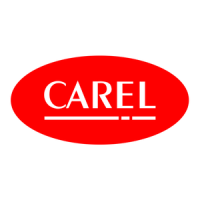S&2ð
cod. Carel +030221826 rel. 2.0 dated 03/10/02
17
,167$//$7,21
$QFKRULQJWKHS&2
The pCO
2
should be installed on a DIN rail. To fasten the unit to the DIN rail, lightly press it against the rail. The rear tabs will
click into place, locking the unit to the rail. Removing the unit is just as simple, using a screwdriver through the release slot to
lever and lift the tabs. The tabs are kept in the locked position by springs.
3RZHUVXSSO\
The pCO
2
can be powered at: 2240Vdc and 24Vac 15%, 50/60Hz. The maximum power consumed is P
max
= 20W.
For alternating current power supplies, during installation use a &ODVV,, safety transformer, rated to at least 50VA and with a
24Vac output. This is valid for the power supply to just one pCO
2
control.
If you supply more pCO
2
controller with the same transformer, its rated voltage must be Q x 50VA, where Q is the number of
controllers to be supplied by the transformer, independently from the controller version.
The power supply to the pCO
2
control and the terminal (or to a series of pCO
2
and terminals) must be separated from the power
supply to the other electrical devices (power contactors and other electromechanical components), inside the electrical panel.
If the transformer secondary is earthed, check that the ground wire is connected to terminal G0. When powering a series of pCO
2
boards connected in a pLAN network, check that the references G and G0 are respected (G0 must be same for all the boards).
The following table summarises the states of the power LEDs.
/(' VWDWXV GHVFULSWLRQ
yellow ON/OFF power supply active / not active
red ON probe power current overload signal (short
circuit or anomaly)
OFF regular probe power
7DE
,QVWDOODWLRQZDUQLQJVGHVWLQDWLRQDQGFRQQHFWLRQHQYLURQPHQWV
Avoid mounting of the boards in environments with the following characteristics:
• relative humidity over 90%;
• strong vibrations or bumps;
• exposure to continuous jets of water;
• exposure to aggressive and polluting environments (e.g.: sulphuric and ammoniac gases, saline mists, fumes) with consequent
corrosion and/or oxidation;
• high levels of magnetic and/or radio-frequency interference (thus avoid installing the machine near transmitting antennae);
• exposure of the pCO
2
to direct sunlight and atmospheric agents in general;
• large and rapid fluctuations in ambient temperature;
• environments where explosives or inflammable gases are present;
• exposure to dust (formation of corrosive patina with possible oxidation and reduction of insulation);
24 Vac / 24 Vdc
yellow red
LED aliment.
)LJ

